I always love the way my kitchen fills with the aroma of Filipino Chicken Curry (Ginataang Manok sa Curry) simmering on the stove. It instantly brings me back to lunches at my Lola's house. I've been cooking this recipe for over a decade now, and let me tell you, this isn't just another curry dish.
Every time I serve this creamy, golden curry sauce over hot rice, watching my family fight over the last potato piece that's perfectly soaked up all that gata-curry goodness, I'm reminded why this is my absolute go-to recipe when I want to make any day feel special.
I've tested countless versions over the years (my poor husband had to eat curry for weeks!), but this recipe right here, it's the perfect balance of creamy gata, tender chicken and that distinctive Filipino curry flavor that's not too spicy but definitely packed with sarap.
You don't need to be a chef to make this. If I could master this Filipino chicken curry recipe as a newlywed who once burned rice, you absolutely can, too! Forget about intimidating Indian or Thai curries, this Filipino version is your friendly introduction to curry cooking, and I promise it'll become your new favorite way to upgrade boring chicken nights.
Jump to:
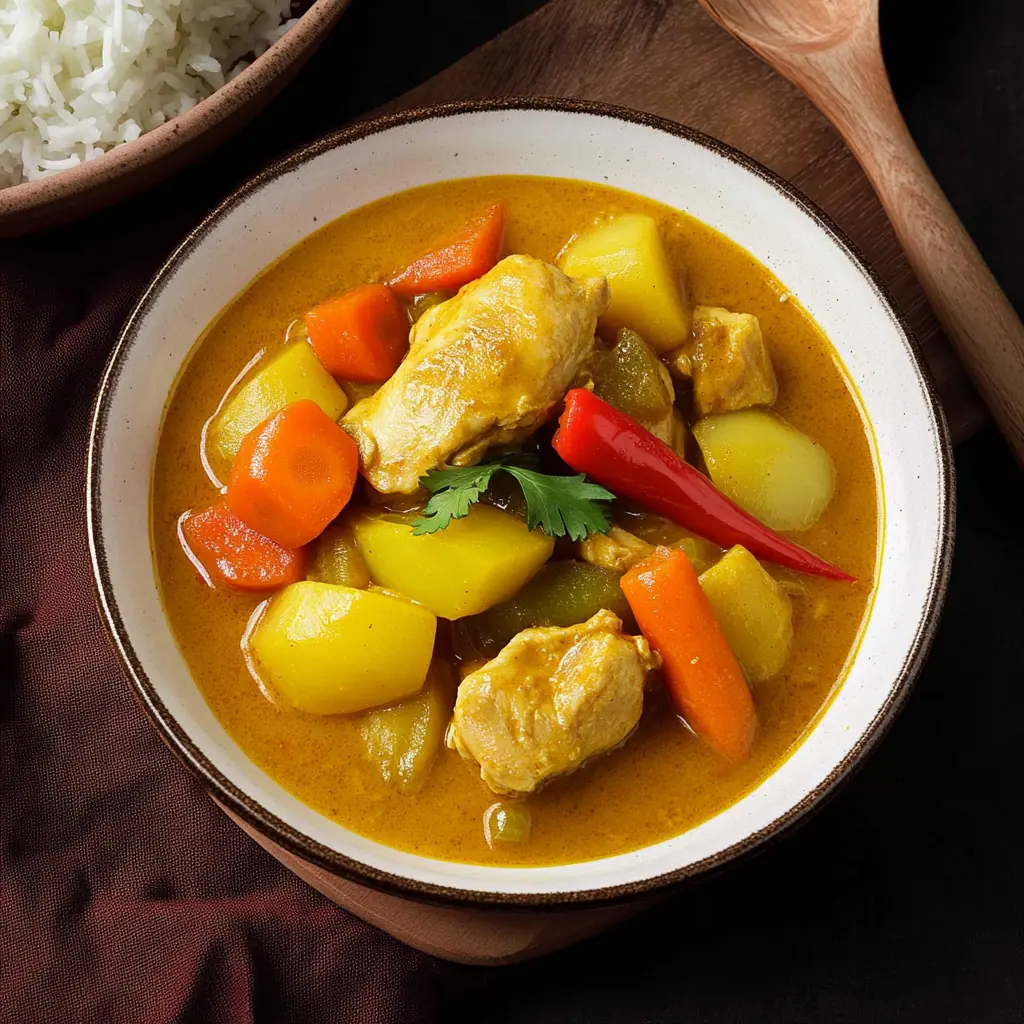
Why You'll Love This Recipe
- Foolproof Method: Step-by-step instructions even beginners can follow
- One-Pot Wonder: Minimal cleanup required
- Budget-Friendly: Uses accessible ingredients
- Make-Ahead Friendly: Tastes even better the next day
- Versatile: Easy to adjust spice levels
- Family-Approved: A crowd-pleasing comfort dish
Ingredients
This Filipino Chicken Curry combines ingredients that create perfect harmony in both flavor and texture. Chicken provides a tender protein base that absorbs the curry spices beautifully. Coconut milk adds creamy richness while balancing the warmth of curry powder.
Potatoes and carrots bring hearty substance and natural sweetness, while bell peppers add vibrant color and a slight crunch. The aromatic trinity of onion, garlic, and ginger forms the flavor foundation, with fish sauce contributing that essential umami depth.
This thoughtful combination creates a dish that's comforting yet complex, with each ingredient playing a crucial role in achieving the perfect balance of flavors that makes Filipino curry distinctively delicious.
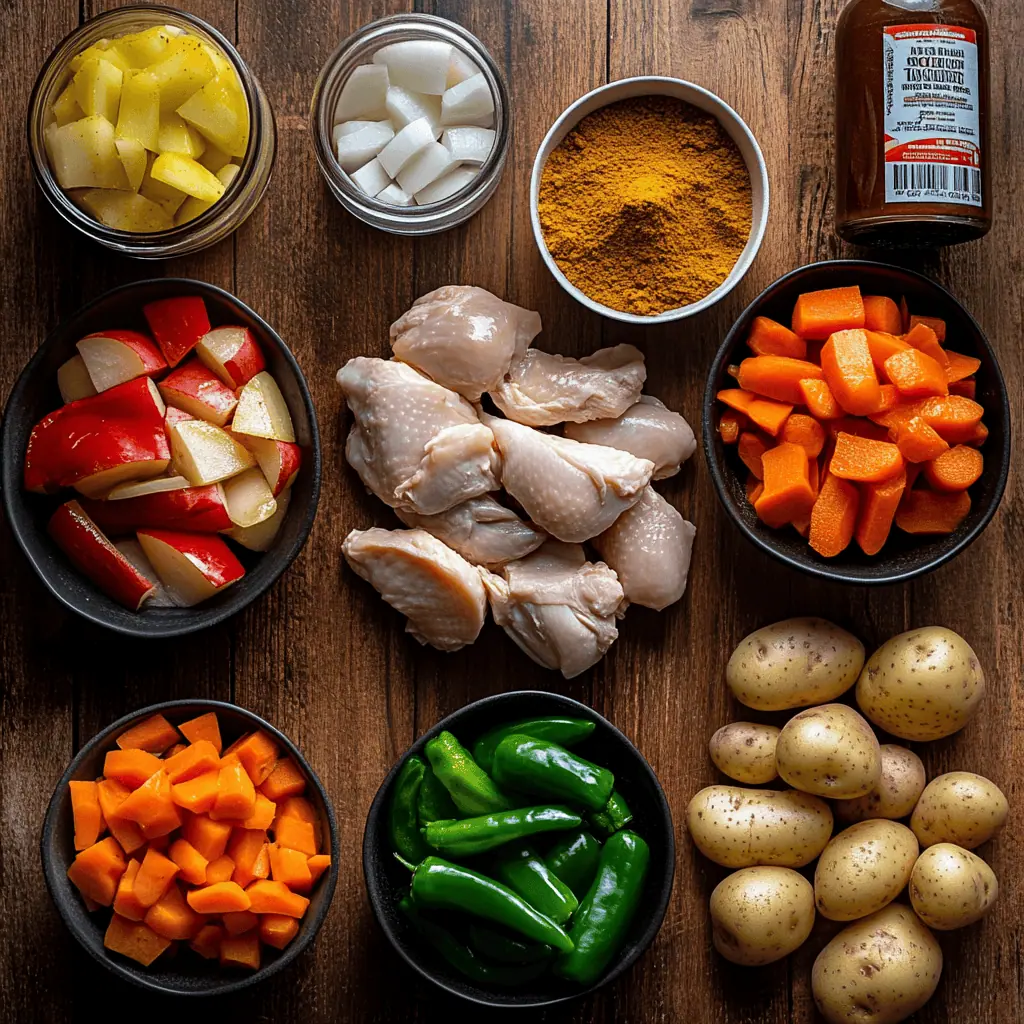
- 3 lbs chicken, cut into serving pieces
- 1 cup coconut milk
- 1 cup water
- 2 medium potatoes, peeled and quartered
- 2 large carrots, peeled and cubed
- 1 green bell pepper, cut into chunks
- 1 red bell pepper, cut into chunks
- 1 onion, cubed
- 3 cloves garlic, minced
- 1-inch ginger, julienned
- 2 tablespoons curry powder
- 1 tablespoon fish sauce
- ¼ cup cooking oil
- Salt and pepper to taste
Equipment
- Large Dutch Oven or Heavy-Bottomed Pot - Provides even heating and prevents burning, essential for properly developing flavors and simmering the curry.
- Sharp Chef's Knife - For efficiently cutting chicken and vegetables into uniform pieces that cook evenly.
- Cutting Board - Preferably with a groove to catch juices when cutting chicken.
- Measuring Cups and Spoons - For accurate ingredient proportions that ensure balanced flavor.
- Wooden Spoon - Ideal for gentle stirring without scraping the pot or breaking up vegetables.
- Ladle - For serving the curry without breaking up the tender pieces.
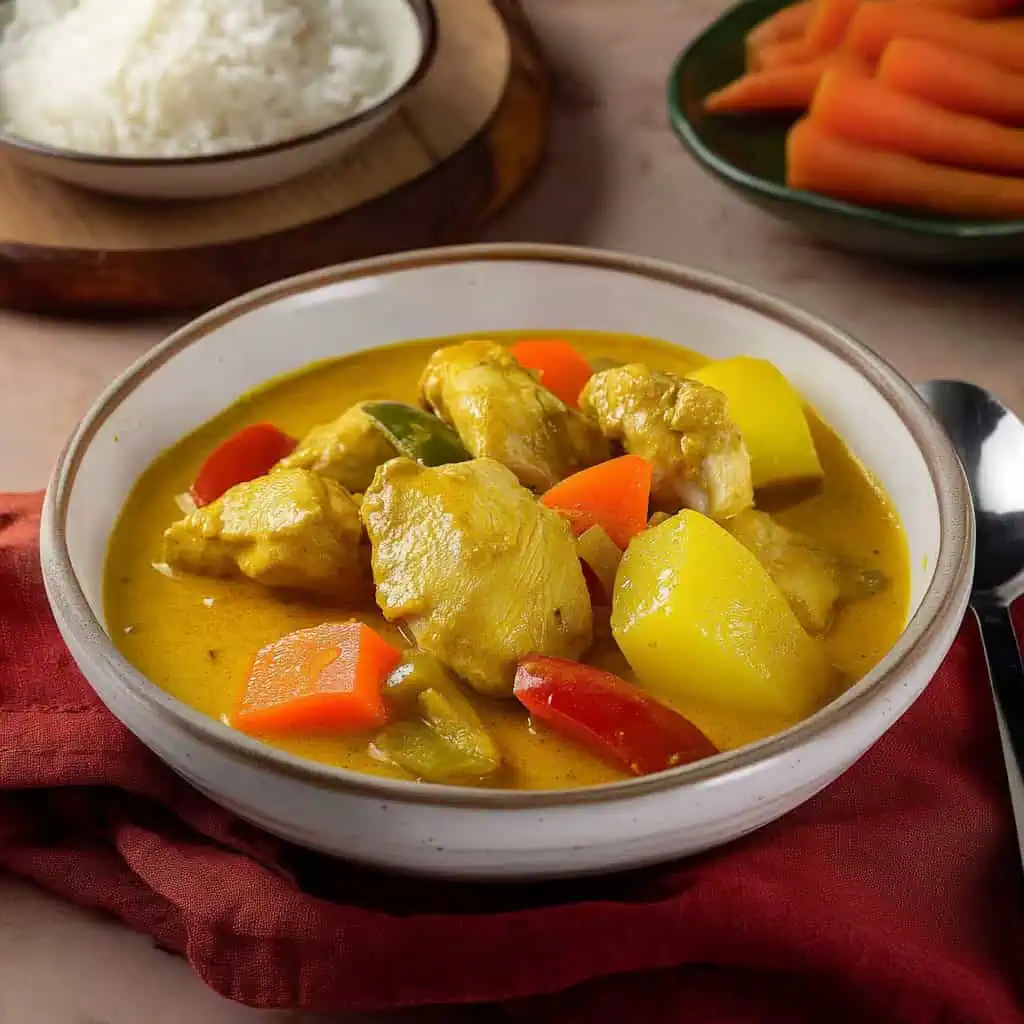
How To Make
- Pat the chicken pieces dry with paper towels and set aside.
- Prepare all vegetables: quarter potatoes, cube carrots, slice bell peppers into chunks, dice onion, mince garlic, and julienne ginger.
- Heat cooking oil in a large pot over medium heat. Once hot, add potatoes and cook until they develop a golden-brown crust, about 3-4 minutes per side. Remove and set aside.
- Using the same pot, cook carrots until slightly tender, about 2-3 minutes. Remove and set aside with potatoes.
- Quickly sauté bell peppers for 1 minute, then remove and set aside with other vegetables.
- In the same pot, add diced onions and cook until translucent and fragrant, about 2-3 minutes.
- Add minced garlic and julienned ginger to the onions. Cook for another minute until aromatic.
- Add chicken pieces to the pot. Cook until lightly brown on all sides, about 5-7 minutes, turning occasionally for even cooking.
- Pour in fish sauce and stir for one minute to distribute the flavor.
- Lower heat to medium-low. Slowly pour in coconut milk and water while gently stirring.
- Bring liquid to a gentle simmer (small bubbles, not rapidly boiling). Cover and cook for 20-25 minutes, until chicken is tender and easily pulls away from the bone.
- Return potatoes and carrots to the pot. Add curry powder while gently stirring to incorporate evenly into the sauce.
- Season with salt and pepper to taste.
- Add bell peppers and simmer uncovered for 5-7 minutes, until sauce has thickened to desired consistency.
- Your curry is ready when the sauce coats the back of a spoon and the oil has separated slightly on top, creating small orange droplets.
- Serve hot with steaming white rice.

Tips from Lola's Kitchen
For Incredibly Tender Chicken:
- Marinate chicken in kalamansi or lemon juice for 30 minutes before cooking
- Use bone-in chicken pieces for more flavor
- Don't rush the simmering process - low and slow is key
For Silky, Perfect Sauce:
- Never boil coconut milk rapidly to prevent curdling
- Stir in one direction when adding coconut milk
- If sauce is too thin, remove lid and simmer to reduce
- Add a small amount of cornstarch slurry (1 teaspoon cornstarch mixed with 1 tablespoon water) if needed for thickening
For Enhanced Flavor:
- Toast curry powder in a dry pan for 30 seconds before using to release aromatics
- Use fresh coconut milk when possible for richer taste
- Add a stalk of lemongrass (bruised) during simmering for extra aroma
- Bloom spices in oil before adding liquids
- Let curry rest covered for 10 minutes before serving to allow flavors to meld
Substitutions
- Chicken: Pork chunks, shrimp, firm white fish, or extra-firm tofu
- Coconut Milk: Canned coconut milk, coconut cream thinned with water
- Fish Sauce: Soy sauce, salt, or shrimp paste
- Bell Peppers: String beans, eggplant, or chayote
- Potatoes: Sweet potatoes, taro, or butternut squash
- Curry Powder: Make your own blend with turmeric, coriander, cumin, and paprika
- Fresh Ginger: Ginger powder (use ¼ teaspoon) or galangal
Troubleshooting
Curdled Coconut Milk
- Problem: Sauce looks grainy or separated
- Solution: Lower heat immediately, avoid boiling, and stir gently in one direction
- Prevention: Always add coconut milk over low heat and never let it reach a rolling boil
Vegetables Too Soft
- Problem: Vegetables have become mushy
- Solution: Remove overcooked vegetables, prepare a fresh batch and add during final 5 minutes
- Prevention: Add firmer vegetables (potatoes, carrots) earlier, softer ones (bell peppers) later
Sauce Too Thin
- Problem: Watery consistency lacking richness
- Solution: Remove lid and simmer 5-10 minutes longer to reduce liquid
- Prevention: Use full-fat coconut milk and ensure proper reduction time
Curry Tastes Bland
- Problem: Lacking depth of flavor
- Solution: Add more curry powder, a splash of fish sauce, or a squeeze of lime
- Prevention: Toast curry powder first and properly season throughout cooking
Storage & Reheating
Refrigeration
- Cool completely before storing
- Store in airtight container for 3-4 days
- Flavors typically improve overnight as spices meld
Freezing
- Freeze for up to 3 months
- For best texture, freeze without potatoes (they can become grainy)
- Cool completely before transferring to freezer-safe containers
- Leave some space at the top for expansion
Reheating
- Stovetop: Low heat with a splash of water or coconut milk; stir occasionally
- Microwave: Medium power for 2-3 minutes, stirring halfway
- Always reheat to at least 165°F (74°C) for food safety
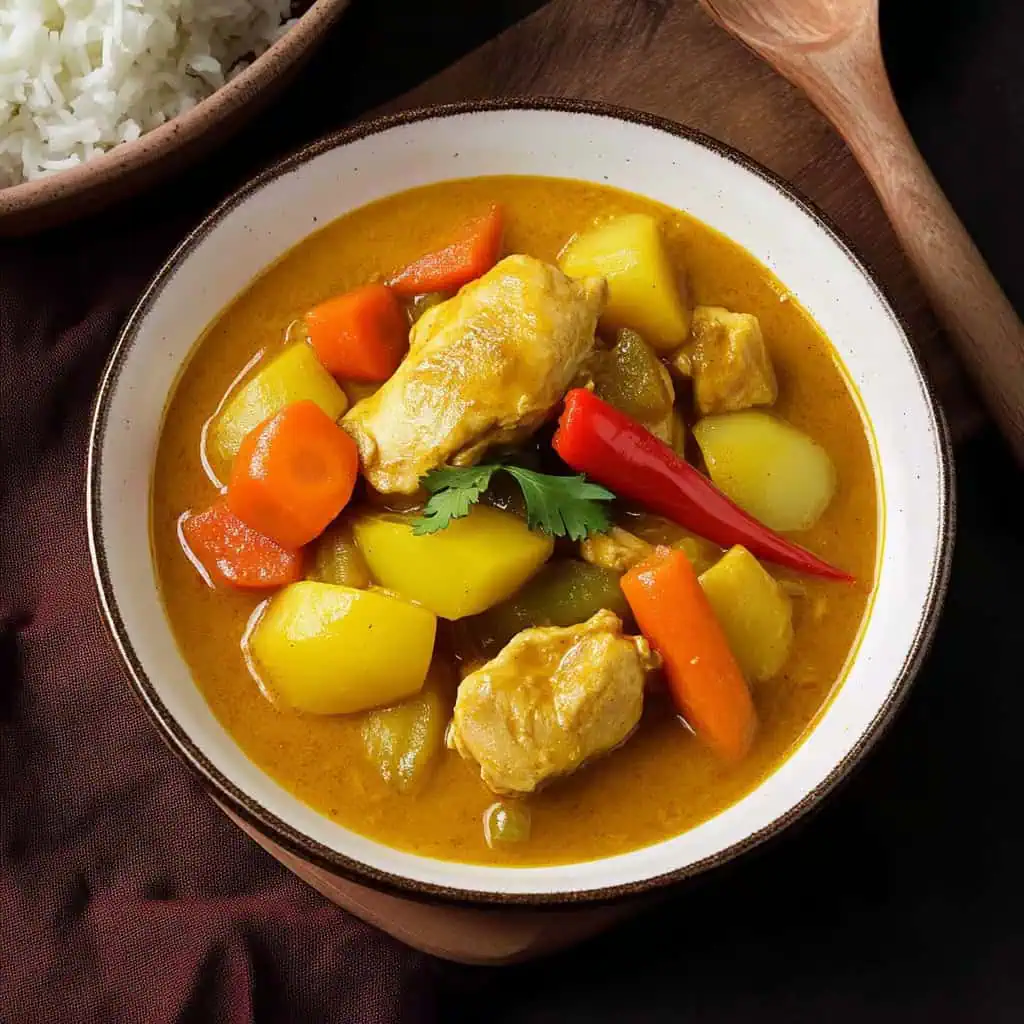
FAQ
Can I use boneless chicken instead?
Yes, boneless chicken thighs or breasts work well. Reduce cooking time by about 10 minutes, as boneless pieces cook faster.
Why did my sauce curdle or separate?
High heat is the most common cause of curdling. Always keep coconut milk at a gentle simmer and avoid rapid boiling.
Can I make this dish ahead for a party?
Absolutely! This curry actually tastes better the next day as flavors continue to develop. Reheat gently before serving.
How spicy is Filipino chicken curry?
Traditional Filipino curry is mild compared to Indian or Thai versions. For more heat, add 1-2 chopped Thai chilies or red pepper flakes.
Can I add other vegetables to this curry?
Yes! Green peas, cauliflower, green beans, and eggplant all work beautifully. Add firm vegetables with the potatoes and softer ones with the bell peppers.
What makes Filipino curry different from other Asian curries?
Filipino curry is milder and creamier due to the coconut milk base. It typically uses pre-mixed curry powder rather than individual spices, creating a more approachable, less intense heat profile.
How do I know when the curry is done?
The chicken should be fork-tender, the sauce should coat the back of a spoon, and you'll see small droplets of oil appearing on the surface.
Can I use curry paste instead of powder?
Yes, but start with half the amount as curry paste is more concentrated. Adjust to taste.
My family prefers a thicker sauce - what should I do?
Simmer uncovered for longer or make a slurry with 1 teaspoon cornstarch mixed with 1 tablespoon cold water and stir it in during the final 5 minutes of cooking.
How can I make this dish healthier?
Use skinless chicken, light coconut milk, and increase the vegetable-to-meat ratio. You can also reduce oil to 2 tablespoons.
Related
Looking for other recipes like this? Try these:
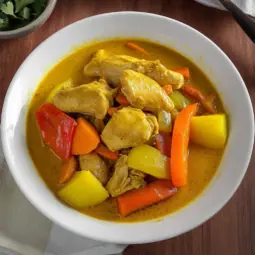
Filipino Chicken Curry (Ginataang Manok sa Curry)
Ingredients
- 3 lbs chicken manok, cut into serving pieces
- 1 cup coconut milk gata
- 1 cup water tubig
- 2 medium potatoes patatas, peeled and quartered
- 2 large carrots peeled and cubed
- 1 green bell pepper berdeng siling pangsigang
- 1 red bell pepper pulang siling pangsigang
- 1 onion sibuyas, cubed
- 3 cloves garlic bawang, minced
- 1- inch ginger luya, julienned
- 2 tablespoons curry powder
- 1 tablespoon fish sauce patis
- ¼ cup cooking oil mantika
- Salt and pepper to taste asin at paminta
Instructions
- Begin by patting the chicken pieces dry with paper towels (punasan ang manok gamit ang paper towel). Set aside.
- Prepare all your vegetables (maghanda ng mga gulay): Peel and quarter the potatoes, cube the carrots into similar sizes, slice the bell peppers into chunks, dice the onion, mince the garlic, and julienne the ginger. Having everything ready before cooking will make the process smoother (mas madali ang pagluluto kapag handa na ang lahat).
- Heat your cooking oil in a large pot over medium heat (180°C/350°F). Once hot, add the potatoes and cook until they develop a golden-brown crust, about 3-4 minutes per side. Remove and set aside (itabi muna).
- Using the same pot, cook the carrots until slightly tender, about 2-3 minutes. Remove and set aside with the potatoes.
- Quickly sauté the bell peppers for 1 minute, then remove and set aside with the other vegetables.
- Keep the pot at medium heat and add your diced onions. Cook them until they become translucent and fragrant (malinaw at mabango), about 2-3 minutes.
- Add the minced garlic and julienned ginger to the onions. Cook for another minute until you can smell their aroma (hanggang mabango).
- Add the chicken pieces to the pot. Cook until they turn lightly brown on all sides, about 5-7 minutes. Make sure to turn them occasionally for even cooking (ibaling-baling para pantay ang luto).
- Pour in the fish sauce (patis) and stir for one minute to distribute the flavor (pampalasa).
- Lower the heat to medium-low (160°C/320°F). Slowly pour in the coconut milk (gata) and water while gently stirring. Remember, gentle heat is key to prevent the coconut milk from curdling (dahan-dahan sa pagbubuhos ng gata para hindi maging buo-buo).
- Bring the liquid to a gentle simmer - you should see small bubbles, but it shouldn't be boiling rapidly). Cover the pot and let it cook for 20-25 minutes, or until the chicken is tender and easily pulls away from the bone.
- Return the potatoes and carrots to the pot. Add your curry powder while gently stirring to incorporate it evenly into the sauce (haluing mabuti para kumalat ang curry powder).
- Season with salt and pepper according to your taste (timplahan ng asin at paminta ayon sa gusto).
- Add the bell peppers last and let everything simmer uncovered for 5-7 minutes, or until the sauce has thickened to your desired consistency (hanggang lumapot ang sarsa).
- Your curry is ready when the sauce coats the back of a spoon and the oil has separated slightly on top, creating small orange droplets (handa na ang curry kapag kumakapit na ang sarsa sa kutsara at may kaunting mantika sa ibabaw).
- Serve hot with steaming white rice (mainit na kanin). The curry will taste even better the next day as the flavors continue to develop (mas sasarap pa kinabukasan).
- To store, let it cool completely then transfer to an airtight container. It will keep in the refrigerator for up to 3 days or in the freezer for up to 2 months. When reheating, do so gently over low heat (140°C/285°F) with a splash of water to maintain the sauce's consistency (painitin sa mahinang apoy at magdagdag ng kaunting tubig).
- For extra spiciness (kung gusto ng maanghang), you can add 1-2 chopped Thai chilies (sili) when you add the curry powder. Start with a small amount and adjust according to your heat preference (magsimula sa kaunti at dagdagan kung gusto pa ng mas maanghang).
Tips from Lola's Kitchen
- For Tender Chicken (Para Lumambot ang Manok)
- Marinate chicken in kalamansi juice for 30 minutes before cooking
- Don't rush the simmering process
- For Perfect Sauce (Para sa Tamang Sarsa)
- Never boil coconut milk rapidly to prevent curdling
- If sauce is too thin, remove lid and simmer to reduce
- For Better Flavor (Para sa Masarap na Lasa)
- Toast curry powder in a dry pan before using
- Use fresh coconut milk when possible
- Add lemongrass (tanglad) for extra aroma
Nutrition
The Story Behind Chicken Curry (Ginataang Manok sa Curry)
Filipino Chicken Curry represents the beautiful evolution of how foreign flavors become distinctly Filipino through local interpretation and ingredients. What makes this dish special isn't its adherence to Indian or Thai curry traditions, but rather how it embraces a uniquely Filipino approach by incorporating creamy gata (coconut milk) and adjusting spice levels to suit the Filipino palate. Unlike its Asian counterparts, Filipino curry focuses on creating a rich, comforting sauce that's perfect for kanin (rice) rather than emphasizing heat or complex spice blends.
The genius of Filipino chicken curry lies in its adaptability and simplicity—curry powder meets coconut milk in a harmonious blend that's made distinctly local through the addition of potatoes, carrots, and bell peppers. Some families add evaporated milk or cheese for extra richness, a uniquely Filipino twist that makes the sauce even more luxurious. The vegetables aren't mere additions; they absorb the curry-coconut sauce and become as cherished as the tender chicken pieces themselves. Local cooks often use Pare brand curry powder, creating that distinctive Filipino curry flavor that's become familiar in households across the country.
Today, while international curry varieties become more accessible, Filipino chicken curry maintains its place as comfort food that perfectly represents how Filipino cuisine makes foreign dishes its own. Whether served at family gatherings or as a special weekday ulam, it demonstrates the Filipino talent for adaptation—creating something that feels both exotic and comfortingly familiar.
Remember: Perfect Filipino chicken curry isn't about authenticity to other curry traditions—it's about achieving that ideal sauce consistency where the coconut milk and curry blend into a rich gravy that's just spiced enough to be interesting but still lets you appreciate the sweetness of the coconut milk.
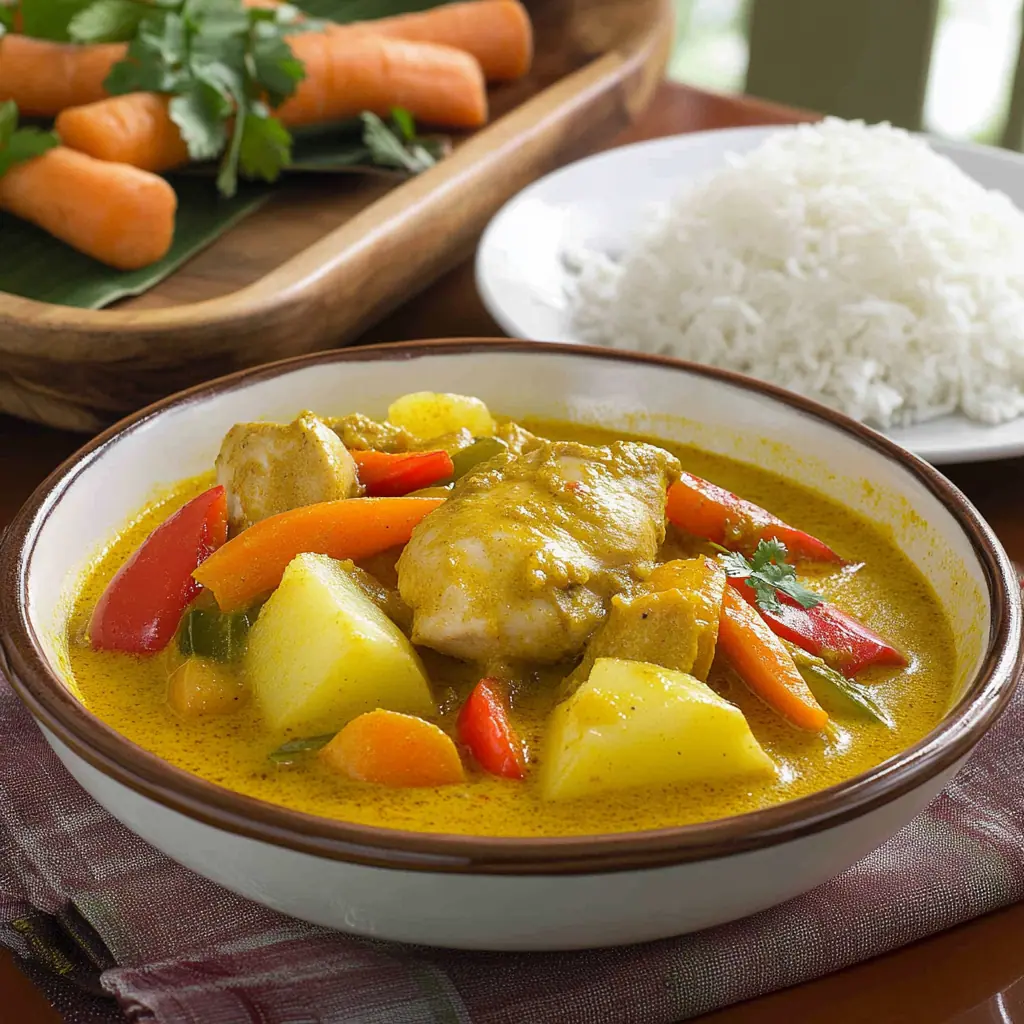









Comments
No Comments